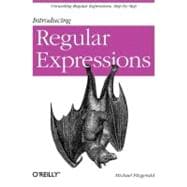
| Preface | p. vii |
| What Is a Regular Expression? | p. 1 |
| Getting Started with Regexpal | p. 2 |
| Matching a North American Phone Number | p. 2 |
| Matching Digits with a Character Class | p. 4 |
| Using a Character Shorthand | p. 5 |
| Matching Any Character | p. 5 |
| Capturing Groups and Back References | p. 6 |
| Using Quantifiers | p. 6 |
| Quoting Literals | p. 8 |
| A Sample of Applications | p. 9 |
| What You Learned in Chapter 1 | p. 11 |
| Technical Notes | p. 11 |
| Simple Pattern Matching | p. 13 |
| Matching String Literals | p. 15 |
| Matching Digits | p. 15 |
| Matching Non-Digits | p. 17 |
| Matching Word and Non-Word Characters | p. 18 |
| Matching Whitespace | p. 20 |
| Matching Any Character, Once Again | p. 22 |
| Marking Up the Text | p. 24 |
| Using sed to Mark Up Text | p. 24 |
| Using Perl to Mark Up Text | p. 25 |
| What You Learned in Chapter 2 | p. 27 |
| Technical Notes | p. 27 |
| Boundaries | p. 29 |
| The Beginning and End of a Line | p. 29 |
| Word and Non-word Boundaries | p. 31 |
| Other Anchors | p. 33 |
| Quoting a Group of Characters as Literals | p. 34 |
| Adding Tags | p. 34 |
| Adding Tags with sed | p. 36 |
| Adding Tags with Perl | p. 37 |
| What You Learned in Chapter 3 | p. 38 |
| Technical Notes | p. 38 |
| Alternation, Groups, and Backreferences | p. 41 |
| Alternation | p. 41 |
| Subpatterns | p. 45 |
| Capturing Groups and Backreferences | p. 46 |
| Named Groups | p. 48 |
| Non-Capturing Groups | p. 49 |
| Atomic Groups | p. 50 |
| What You Learned in Chapter 4 | p. 50 |
| Technical Notes | p. 51 |
| Character Classes | p. 53 |
| Negated Character Classes | p. 55 |
| Union and Difference | p. 56 |
| POSIX Character Classes | p. 56 |
| What You Learned in Chapter 5 | p. 59 |
| Technical Notes | p. 60 |
| Matching Unicode and Other Characters | p. 61 |
| Matching a Unicode Character | p. 62 |
| Using vim | p. 63 |
| Matching Characters with Octal Numbers | p. 64 |
| Matching Unicode Character Properties | p. 65 |
| Matching Control Characters | p. 68 |
| What You Learned in Chapter 6 | p. 70 |
| Technical Notes | p. 71 |
| Quantifiers | p. 73 |
| Greedy, Lazy, and Possessive | p. 74 |
| Matching with *, +, and ? | p. 74 |
| Matching a Specific Number of Times | p. 75 |
| Lazy Quantifiers | p. 76 |
| Possessive Quantifiers | p. 77 |
| What You Learned in Chapter 7 | p. 78 |
| Technical Notes | p. 79 |
| Lookarounds | p. 81 |
| Positive Lookaheads | p. 81 |
| Negative Lookaheads | p. 84 |
| Positive Lookbehinds | p. 85 |
| Negative Lookbehinds | p. 85 |
| What You Learned in Chapter 8 | p. 86 |
| Technical Notes | p. 86 |
| Marking Up a Document with HTML | p. 87 |
| Matching Tags | p. 87 |
| Transforming Plain Text with sed | p. 88 |
| Substitution with sed | p. 89 |
| Handling Roman Numerals with sed | p. 90 |
| Handling a Specific Paragraph with sed | p. 91 |
| Handling the Lines of the Poem with sed | p. 91 |
| Appending Tags | p. 92 |
| Using a Command File with sed | p. 92 |
| Transforming Plain Text with Perl | p. 94 |
| Handling Roman Numerals with Perl | p. 95 |
| Handling a Specific Paragraph with Perl | p. 96 |
| Handling the Lines of the Poem with Perl | p. 96 |
| Using a File of Commands with Perl | p. 97 |
| What You Learned in Chapter 9 | p. 98 |
| Technical Notes | p. 98 |
| The End of the Beginning | p. 101 |
| Learning More | p. 102 |
| Notable Tools, Implementations, and Libraries | p. 103 |
| Perl | p. 103 |
| PCRE | p. 103 |
| Ruby (Oniguruma) | p. 104 |
| Python | p. 104 |
| RE2 | p. 105 |
| Matching a North American Phone Number | p. 105 |
| Matching an Email Address | p. 105 |
| What You Learned in Chapter 10 | p. 106 |
| Appendix: Regular Expression Reference | p. 107 |
| Regular Expression Glossary | p. 123 |
| Index | p. 129 |
| Table of Contents provided by Ingram. All Rights Reserved. |
The New copy of this book will include any supplemental materials advertised. Please check the title of the book to determine if it should include any access cards, study guides, lab manuals, CDs, etc.
The Used, Rental and eBook copies of this book are not guaranteed to include any supplemental materials. Typically, only the book itself is included. This is true even if the title states it includes any access cards, study guides, lab manuals, CDs, etc.